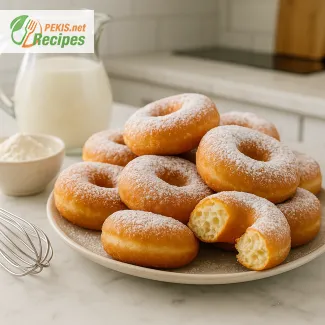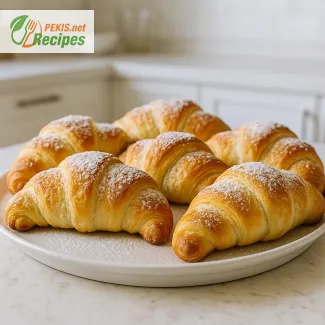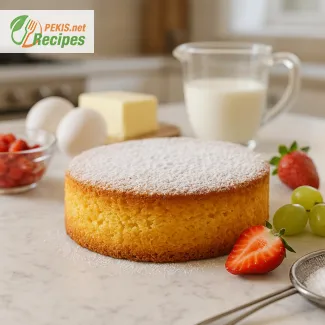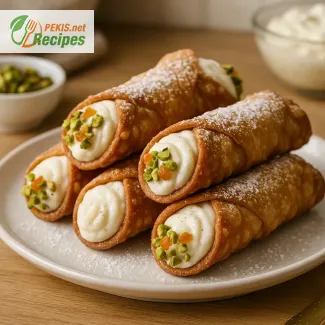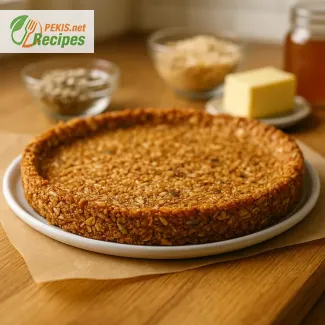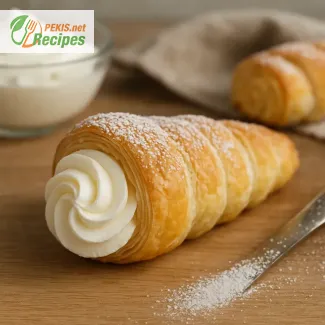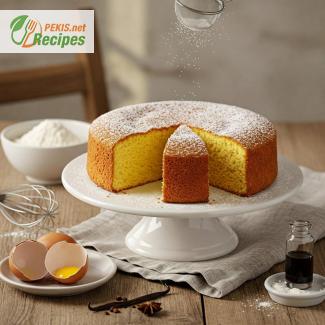
The Ultimate Fluffy Sponge Cake for Every Celebration
Discover the secret to the perfect cake foundation with this light and airy sponge
There's something undeniably nostalgic and comforting about a homemade sponge cake. Its simple, unpretentious appearance hides the magic of its texture—light, airy, and delightfully soft. Whether layered with rich buttercream, fresh fruit, silky ganache, or simply dusted with powdered sugar, a sponge cake is the versatile base that brings your cake creations to life. From birthday parties and weddings to Sunday family lunches or afternoon tea, the humble sponge cake stands tall as the essential starting point for layer cakes of all kinds.
This particular sponge cake recipe has earned its place in countless kitchens for its ease of preparation, reliable results, and sublime texture. With just a few pantry staples—eggs, sugar, flour, and a hint of vanilla—this cake proves that sometimes, the most elegant outcomes stem from the simplest of ingredients. And what truly sets it apart is the careful balance between moistness and lightness, creating a structure that’s firm enough to hold multiple layers, yet soft enough to melt in your mouth with every bite.
If you’ve ever struggled with sponge cakes that collapse, turn rubbery, or dry out too quickly, you’ll appreciate the foolproof nature of this method. It’s designed with both beginner bakers and experienced enthusiasts in mind. By using well-tested techniques like beating the eggs to just the right volume and folding in the flour with precision, you’ll achieve a cake base that rises beautifully, maintains its form, and provides the ideal canvas for further creativity.
What makes this sponge cake truly remarkable is its adaptability. It can be flavored subtly with lemon zest for a spring dessert, enhanced with cocoa powder for a chocolate version, or even soaked in syrup for a more decadent experience. Thanks to its neutral yet buttery flavor profile, it pairs beautifully with whipped cream, jam, mousses, and custards. No matter how you decide to dress it up, the texture remains consistently soft and balanced—a true sign of a perfectly baked sponge.
This cake has become a staple in professional kitchens and home bakeries alike. It’s the kind of recipe that gets passed down through generations, tweaked to suit personal tastes, and cherished for its consistent, bakery-quality results. Its delicate crumb and golden edges make it not only a joy to eat but also a delight to look at once assembled and decorated. And for anyone diving into the world of cake decorating, this sponge provides a sturdy, stable base that doesn't crumble under pressure.
Beyond the visual and textural appeal, there's a sense of joy that comes from pulling a freshly baked sponge from the oven. The sweet aroma that fills the kitchen, the warm golden hue, and the slight spring when touched—it’s a reminder of how satisfying baking can be. There’s a certain pride in crafting a base that not only supports your cake but also elevates every flavor you choose to add on top.
As cakes continue to evolve in complexity and style, from mirror glazes and drip cakes to naked and semi-naked designs, the sponge cake remains the unshakable classic. It’s that foundational recipe every baker needs in their repertoire—timeless, versatile, and endlessly delicious.
In the sections that follow, we’ll guide you through the exact measurements, techniques, and tips for ensuring your sponge cake turns out flawlessly every time. Whether you’re planning a multi-tiered birthday masterpiece or just want something simple and satisfying with a cup of tea, this recipe will become your go-to for dependable, delicious results.
- Preheat your oven to 175°C (350°F). Grease and line the bottom of a 24 cm (9-inch) round cake pan with parchment paper.
- In a large mixing bowl, crack the eggs and add the granulated sugar.
- Using a stand mixer or hand mixer, beat the eggs and sugar on high speed for 8–10 minutes, or until the mixture becomes thick, pale, and triples in volume.
- Add the vanilla extract and lemon zest, and mix briefly to incorporate.
- In a separate bowl, sift together the flour, cornstarch, baking powder, and salt.
- Gently fold the dry ingredients into the egg mixture in three additions, using a spatula or balloon whisk. Be careful not to deflate the mixture.
- Pour the batter into the prepared pan and gently smooth the surface.
- Bake for 28–32 minutes, or until the top is golden and a toothpick inserted in the center comes out clean.
- Let the cake cool in the pan for 10 minutes, then run a knife along the edge and remove it from the pan. Allow it to cool completely on a wire rack.
- Once cooled, the sponge can be sliced into layers and filled as desired.
Enhancing the Classic Sponge Cake to Perfection
Practical tips to elevate flavor, texture, and health in your homemade sponge cake
A traditional sponge cake is a timeless dessert loved for its simplicity, light texture, and subtle sweetness. However, there is always room for improvement, whether you're baking for a special occasion or just indulging your love for homemade treats. By making small changes to ingredients or methods, you can significantly impact the final result—enhancing the flavor, texture, and even the nutritional value of your sponge cake.
Adding richness without losing lightness
The standard sponge cake relies on eggs, sugar, and flour to create its signature airy structure. However, adding a touch of melted butter (30 g / 2 tbsp) or neutral oil (30 ml / 2 tbsp) can enrich the cake’s flavor and give it a slightly moister crumb, while still retaining its light texture. When incorporating fat, it's essential to fold it in gently at the end of mixing, ensuring you don't deflate the aerated batter. This method balances the cake’s fluffiness with a more tender, luxurious bite.
Adding full-fat Greek yogurt (50 g / ¼ cup) or sour cream is another way to enhance the richness. These ingredients introduce acidity, which reacts with baking powder to produce a subtle lift and a creamy finish on the palate.
Boosting flavor with natural additions
The basic sponge cake is intentionally neutral, making it perfect for various fillings and toppings. Yet, for a standalone sponge or a more exciting base layer, introducing natural flavorings can elevate the experience. Adding citrus zest such as lemon, orange, or lime infuses the cake with brightness and depth. Just a small amount—around 1 g (¼ tsp)—can provide a noticeable enhancement.
Other excellent options include:
- Almond extract (2 ml / ½ tsp) for a nutty undertone
- Vanilla bean paste instead of vanilla extract for more intense flavor
- Spices like cardamom or cinnamon for warmth and complexity
These subtle changes can transform a simple sponge into something truly memorable.
Making it healthier without compromising taste
If you're looking for ways to lighten up the recipe, consider replacing part of the all-purpose flour with whole wheat flour (up to 30%). While this change will slightly darken the color and increase density, it adds fiber and nutrients.
Using unrefined sugars, such as coconut sugar or maple syrup, can provide a more complex sweetness and lower glycemic index. Be mindful of liquid sweeteners, as they may require slight adjustments in dry ingredients to maintain balance.
For a dairy-free version, plant-based yogurts or buttermilk alternatives can be used in modified sponge recipes, while aquafaba serves as a reliable egg substitute when whipped to stiff peaks.
Common mistakes and how to avoid them
Many bakers encounter issues with sponge cakes collapsing or becoming rubbery. To avoid these, remember the following:
- Don’t undermix or overmix: Beat the eggs and sugar thoroughly, but gently fold in the dry ingredients to retain air.
- Avoid opening the oven too early: This can cause the cake to collapse. Wait at least 25 minutes before checking.
- Use room temperature ingredients: Cold eggs and sugar won’t incorporate as well, which affects structure.
- Measure flour correctly: Too much flour can make the cake dense. Always sift and use a scale if possible.
- Use the right pan size: Overfilling or underfilling can affect how evenly the sponge bakes.
Why homemade always tastes better
There’s no denying that homemade sponge cake offers a fresher, more authentic flavor than store-bought versions. Without preservatives or artificial flavorings, the taste of eggs, sugar, and flour shines through. Baking at home allows you to control every ingredient, adapt to dietary needs, and avoid unnecessary additives.
More importantly, a freshly baked sponge cake has a texture and aroma that pre-packaged alternatives simply can’t replicate. The gentle crispness of the crust, the soft sponge interior, and the wafting scent of vanilla or lemon zest create an experience that connects us to tradition, comfort, and creativity.
Creative twists to make it your own
A sponge cake is the perfect base for experimentation. Try adding:
- Chopped nuts or toasted coconut flakes for texture
- Crushed freeze-dried berries for visual appeal and tartness
- Layered flavors by adding a swirl of chocolate or matcha powder
- A splash of liqueur like Grand Marnier or Amaretto to enhance sophistication
If you’re making a layer cake, consider brushing the sponge with a simple syrup infused with herbs like rosemary or thyme, adding subtle fragrance and moisture.
Making the most of presentation and pairing
The aesthetics of your sponge cake matter just as much as the flavor. A light dusting of powdered sugar or a glaze made with citrus juice and icing sugar can elevate the cake's appearance with minimal effort. For more elaborate designs, stack the sponge with whipped cream, custard, or buttercream between layers, and finish with fresh fruits or edible flowers.
Pair your cake with beverages like Earl Grey tea, espresso, or sparkling wine, depending on the occasion. The cake’s neutral flavor makes it highly adaptable to both sweet and savory accompaniments.
Elevating your sponge cake
Enhancing a classic sponge cake doesn’t require complex techniques or rare ingredients—just a willingness to explore subtle variations and understand the impact each component has. By fine-tuning your process and playing with flavor, texture, and nutrition, you can transform an already beloved recipe into a signature creation that reflects your taste, style, and passion for baking.
- Eggs
- Wheat (gluten)
To remove allergens:
- Eggs: Replace with 90 g (6 tbsp) aquafaba (chickpea brine), whipped, plus 1 tsp baking soda.
- Wheat (gluten): Use a certified gluten-free flour blend with xanthan gum to maintain structure (150 g), and ensure cornstarch is gluten-free.
- Vitamin A: 70 µg – supports vision and immune function
- Vitamin B2 (Riboflavin): 0.15 mg – contributes to energy metabolism
- Vitamin B12: 0.5 µg – supports red blood cell formation
- Iron: 0.8 mg – essential for oxygen transport
- Calcium: 25 mg – supports bone health
- Magnesium: 8 mg – helps regulate muscle and nerve function
- Phosphorus: 55 mg – supports cell repair and bone strength
- Selenium: 8 µg – helps protect cells from oxidative stress
- Lutein + Zeaxanthin: 30 µg – supports eye health
- Vitamin E: 0.3 mg – protects against free radical damage
- Beta-carotene: 20 µg – contributes to skin health and immunity
